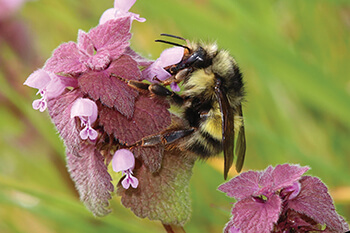
Beekeepers are frequently at odds with the biologists who promote native bee conservation. Native bee advocates claim honey bees are stealing all the forage, while beekeepers resent land that is off limits to bee hives. But in truth, bees are bees.
Although I’m fascinated by how the species are different, I’m also intrigued by their similarities. Every time I run into one of those lists with titles like “Amazing facts about honey bees!” I scan them for accuracy. Although the facts listed may be true, they usually apply to all bees. For example, you might read “A drone can’t sting!” So? Neither can any other male bee. It’s like saying poodles bark or goldfish swim.
As honey bees evolved to live in colonies that could overwinter, they retained traits that were useful and lost others. It’s a great story, but we need to recognize that many bee species remained solitary because the system worked for them. Because bees are bees, what is good for one species is likely good for the rest, so if we can build a better environment for one, we’re building it for all.
Why Regenerative Organic is Different
Last month, I had the pleasure of speaking with Andrew Smith, an entomologist/agronomist with the Rodale Institute, the group that is promoting the new Regenerative Organic Certification. He had me on board the instant he explained that part of their mission is to help pollinators thrive, regardless of whether they are managed species or wild. He believes that caring for the ecosystem, rather than a single species, is key to pollinator health.
According to Smith, Regenerative Organic is far more concerned with ecosystem health than the National Organic Program (NOP) that is currently in place. As it stands today, the NOP is focused primarily on restricting chemical inputs, so we’ve come to think of organic products as simply having minimal chemical exposure. Smith explained that “The current NOP system simply glosses over issues like biodiversity, soil health, and animal welfare.”
The Initial Organic Vision
Back in the 1980s when the organic program first evolved, J.I. Rodale and Dr. Rudolf Steiner envisioned an ecologically-based program that incorporated animal welfare and social justice alongside the restriction of chemical inputs. They believed that, “It is essential to farm in a way that enriches rather than degrades the soil, and values both animals and workers.” Although the NOP gives lip service to all three areas, there is currently very little in the way of oversight for the animal welfare and social justice aspects of organic agriculture. Basically, when it comes to animal and human welfare, the NOP accepts the word of the grower that he is implementing best practices.
In contrast, the new certification program stresses the three modules of soil health and land management, animal welfare, and farmer and worker fairness. Furthermore, each module has three tiers of achievement: bronze, silver, and gold. The grower must demonstrate compliance at each level before he is eligible to receive certification and move further along the pathway.
The animal welfare and social justice requirements of Regenerative Organic go much further than the NOP ever envisioned. In addition, the new program puts much more emphasis on ecosystem fitness, stressing both biodiversity and soil health, each of which have a substantial impact on pollinators and beneficial insects.
Soil Health and Organic Matter
Any gardener will tell you that nothing beats organic matter for improving the soil. Decomposing life forms hold soil particles together and give soil its structure. Soil that is high in organic matter contains many nutrients, drains well, has tunnels and channels that allow oxygen exchange, and supports a great diversity of life. In addition, organic matter breaks up clay, which means the soil is less likely to shrink and expand, water is less likely to puddle, and roots are better able to penetrate the ground. And soil rich in organic matter does not dry and shatter in the sun like pieces of broken pottery. Everything good about soil comes from those decomposing plants, animals, fungi, and microbes.
However, in chemically-supported agriculture, organic matter is sadly lacking. Nutrients are provided to crops in the form of fertilizer, and because organic matter is not returned to the soil, the fields become dusty and ….


